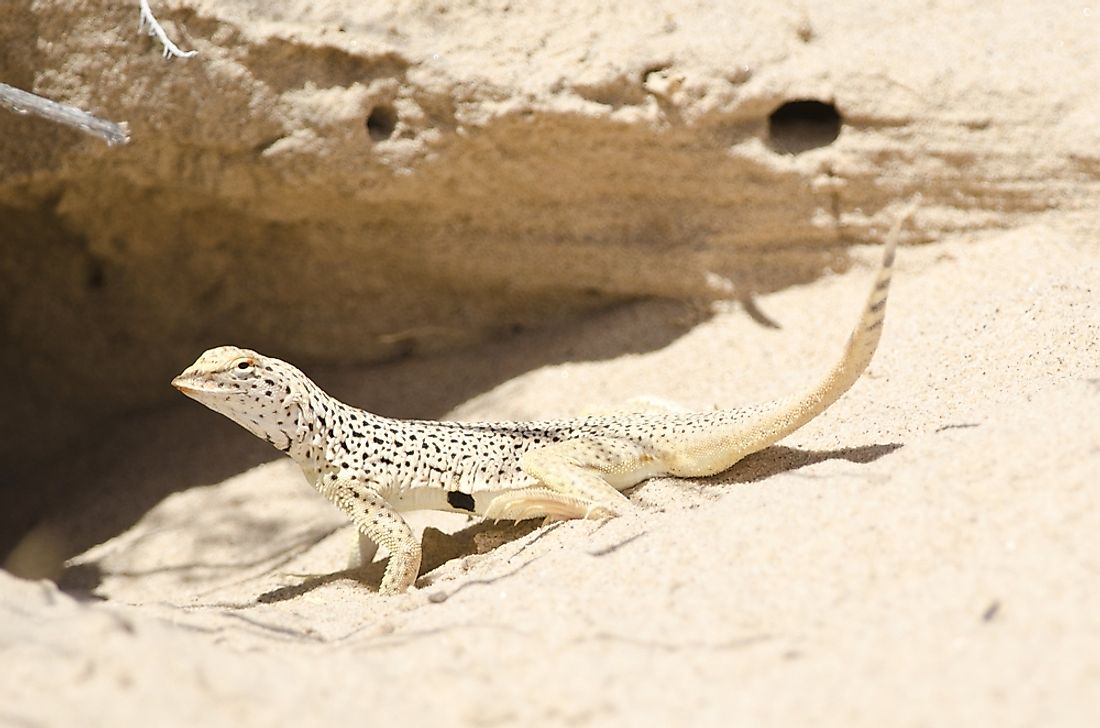Fringe-Toed Lizard Facts: Animals of North America

5. Physical Description
The fringe-toed lizard is a small- to medium-sized five-toed reptile with granular scales, a pointed snout, and a long, delicate tail. Its toes have special pointed scales, which have a likeness to a fringe. These fringe-like scales allow it to walk atop loose sand, and allow for the lizard to burrow by aiding in the digging of dirt and sand. The fringe-toed lizard also has valves in its nostrils, as well as a countersunken lower jaw, which help keep the sand out of its nose and mouth when burrowing. The fringe-toed lizard has moderately large eyes which possess moveable lids.
4. Diet
The fringe-toed lizard is an insectivorous predator, dining mostly upon a diet comprised by a variety of insects and terrestrial invertebrates. On occasion, the lizard may be seen eating desert plant matter, such as seeds, flower buds, and leaves. The adult fringe-toed lizards may also eat hatchling lizards as well.
3. Habitat and Range
Fringe-toed lizards can be found in the deserts of North America, especially in the northwest of Mexico and the US states of Arizona and California. They live primarily on wind-blown sand deposits characterized by sparsely vegetated areas. They may live on dunes, flats with sandy hummocks surrounding vegetation, or even riverside banks. They require soft, loose sand into which they can easily burrow. There are a total of four species of the fringe-toed lizard genus, Uma. Namely, these include Uma Notata, Uma Inornata and Uma Scoparia, which are all subspecies of the Uma Notata. The Coachella Valley Fringe-toed Lizard (Uma Inornata) can be found in in Coachella Valley, in Riverside County, California. It is an "Endangered" subspecies. The Colorado Fringe-toed Lizard (Uma Notata) can be found in the Colorado Desert, and it is a "Threatened" species. The Mohave Fringe-toed Lizard (Uma Scoparia) can be found in the Mohave Desert, and this subspecies is more populous, and therefore considered a species of "Least Concern" in the IUCN Red List category scheme. The Yuman Desert Fringe-toed Lizard (Uma Rufopunctata) can be found in the extreme southwestern corner of the United States and the extreme northwestern corner of Mexico. It is categorized as being "Nearly Threatened" under the Red List Category. The Mexican Fringe-toed lizard (Uma Paraphygas) can only be found in the Mapimi region in Mexico. It is also listed as "Nearly Threatened" under the Red List Category as well. The Coahuila Fringe-toed Lizard (Uma Exsul) is another species found in Mexico, specifically in western Coahuila, Mexico. It is itself an "Endangered Species".
2. Behavior
The fringe-toed lizard is a diurnal animal that buries itself underground during the winter. Over the winter, they will hide in their burrows beginning in early November, once again emerging in February. They also burrow as a means of protecting themselves against extreme temperatures. The fringe-toed lizard typically sleeps buried under sand at night. In the morning, the lizard pokes its head out from its burrow to warm up using the sun’s rays, as it is a "cold-blooded" animal, and requires external heat to carry out its body functions most effectively. Once it is sufficiently warmed up, the lizard will emerge to continue sunning its entire body, or will begin its daily activities.
1. Reproduction
The fringe-toed lizard is a seasonal breeder, and they begin their mating season in May. As a reptile, they lays eggs. Typically, the fringe-toed lizard will lay up to five eggs between May and August. During this time, multiple clutches will be laid in places with the most ideal conditions, as determined by the mother. The incubation period typically lasts 60 days, after which time the eggs are hatched.











